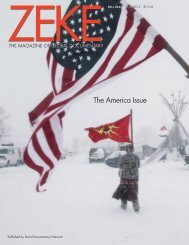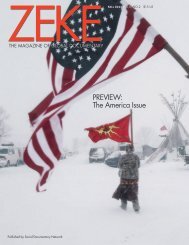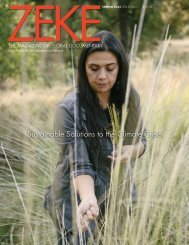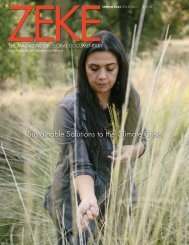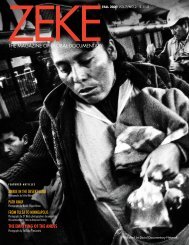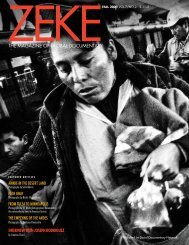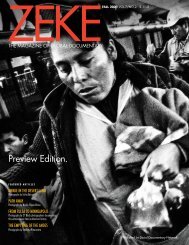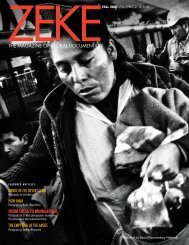ZEKE Magazine: Spring 2023.2
Feature articles on Ecuador by Nicola Ókin Frioli; Ethiopia by Cinzia Canneria, and Ukraine by Svet Jacqueline. Contents: Piatsaw:A Document on the Resistance of the Native Peoples of Ecuadorian Amazon Against Extractivism Photographs by Nicola Ókin Frioli Winner of 2023 ZEKE Award for systemic change Women's Bodies as Battlefield Photographs by Cinzia Canneri Winner of 2023 ZEKE Award for documentary photography Too Young to Fight, Ukraine Photographs by Svet Jacqueline Picturing Atrocity: Ukraine, Photojournalism, and the Question of Evidence by Lauren Walsh Interview with Chester Higgins by Daniela Cohen
Feature articles on Ecuador by Nicola Ókin Frioli; Ethiopia by Cinzia Canneria, and Ukraine by Svet Jacqueline.
Contents:
Piatsaw:A Document on the Resistance of the Native Peoples of Ecuadorian Amazon Against Extractivism
Photographs by Nicola Ókin Frioli
Winner of 2023 ZEKE Award for systemic change
Women's Bodies as Battlefield
Photographs by Cinzia Canneri
Winner of 2023 ZEKE Award for documentary photography
Too Young to Fight, Ukraine
Photographs by Svet Jacqueline
Picturing Atrocity: Ukraine, Photojournalism, and the Question of Evidence
by Lauren Walsh
Interview with Chester Higgins
by Daniela Cohen
You also want an ePaper? Increase the reach of your titles
YUMPU automatically turns print PDFs into web optimized ePapers that Google loves.
Subscribe to ZEKE today and
receive print edition. Learn more » »
BEAUTIFUL, STILL
by Colby Deal
Mack, 2022 | 160 pages | $55
Colby Deal’s first monograph
Beautiful, Still is filled with photographs
in motion. A face turns
to the side and leaves a trail of light,
a child crawls in his mother’s arms.
Between the shutter’s open and close,
subjects move, leaving behind only a
trace: a flick of a person, of a place,
of a moment in time in Houston’s Third
Ward. These images in motion are a
reminder that traces can tell a whole
story. There is power in nuance.
Beautiful, Still carries itself like a family
album. The cover, a deep red with an
embedded gold title, holds black and
white images that seem to come from
no particular time. In grayscale, the
story separates from the specific, that
is the documentation of this community.
Disentangled from color, the images
represent more than the particular, and
begin to read more abstractly. The specific
is further complicated by variations in
style. Crisp portraits accompany blurry
still lives and bright whites of day are
countered by photographs from a night
stroll. In these visual antonyms Deal tries
to capture the broadest sense of the Third
Ward community in anticipation of death
by gentrification.
The Third Ward is historically Black.
Following the Civil War and into the
1950s White flight, the area became
predominantly African American – not
solely on the basis of population, but in
all aspects: the only African-American
owned bank (Unity), a non-profit hospital
for Black patients staffed by Black doctors
(Riverside), and multiple civil rights organizations.
The Third Ward is also a catch-all
name for multiple communities. As Garry
Reece puts it in the brilliant afterword to
the book, “which Third Ward we visited
depended on which auntie we visited.”
For the last couple of decades there has
been a White resurgence, a wave of gentrification.
A University of Houston (UH)
webpage dedicated to the Third Ward
describes the university’s own initiatives
to “revitalize” and “enhance” the area.
Reece, on the other hand, addresses UH
as one of the biggest drivers of gentrification.
From this process, in any way it’s
named, comes the urgency of Beautiful,
Still and the attempt to capture what may
be soon gone.
There is a ghostliness to the book.
Particularly spectral are several images of
women dressed in white. Their bleached
white dresses pierce through the gray
of the photograph. Deal enhances
this ghostliness by inviting in dust and
scratches. Rather than removing this
added layer, Deal allows it to function as
its own presence. This creative decision
is one of many in the making of this
book, which mark the tension between
documentary practice and art, between
the concrete and the abstract, between
the word and the poem.
This tension in Beautiful, Still is owed
in part to the complexity of subject matter.
Historical fact, personal relationships,
and photographic technique all precede
this book. To address the various facets,
Deal packs the book with an abundance
of photographs, often piling together four
images into a single spread. One of the
strengths of the work then becomes its
weakness, as the big picture outshines
the individual photograph. While many
images together allow the artist to build a
comprehensive narrative, there is power
to be found in a single picture and in the
space between photographs.
While the sequencing in Beautiful,
Still reads as poetry, there is also a sense
of loss. Beautiful, Still is a broad and
aesthetic journey through the Third Ward
Colby Deal, Image from Beautiful, Still. (MACK,
2022). Courtesy of the artist and MACK.
and Deal’s photography is both delicate
and powerful. Even so, and especially
owing to this artistry, much of the book
could have been said with fewer words.
In this book are outstanding individual
photographs which stand out as
microcosms. One such image is simply
a street view. The photograph seems to
split at the equator: the north is a house
with blocked out windows, and the south
is a grassy piece of earth. The focus
falls somewhat in the center, on a white,
studded lounge chair. It’s worn out and
torn, and still dazzling white, as if just
washed. It is a trace of life, forgotten and
left behind, yet still precious. Then there
are the shoes. One lies abandoned by
the chair, and the other is attached to a
body in motion. The person moves too
quickly for the shutter to capture, but the
shoe stays still. Crisp. This is an image
meant to be read for hours, to be looked
at over again. In it is the trace of a
place. In it is the resolution of the tension
between documentary practice and art,
concrete and abstract, word and poem.
—Dana Melevar
ZEKE SPRING 2023/ 59








